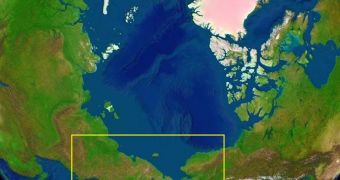Over the past few million years, Asia and North America have been intermittently linked via a land strip from time to time. Researchers were recently able to demonstrate that the presence of this strip is what caused the massive climate swings that characterized the last ice age.
Between 80,000 and 10,000 years ago, average temperatures in the North Atlantic Ocean basin exhibited extreme variations, which left their marks on the geological record. Until now, experts could not find an encompassing explanation for this.
Some scientists suggested that important variations in solar activity may have caused these changes, whereas others said that a host of unstable climate processes may have been to blame. The new investigation suggests that neither of these phenomena can be held accountable.
More likely, the presence of a land strip connecting modern-day Alaska and Siberia hampered oceanic circulation patterns, and lead to a destabilization of the North Atlantic climate, Science Now reports.
What puzzled researchers the most when analyzing ancient climate records was the fact that the temperature variations reached as much as 10 degrees Celsius, but lasted only 10 to 20 years at a time.
Usually, millions of years are needed for such drastic changes to occur, says Aixue Hu, who holds an appointment as a climate scientist at the national Center for Atmospheric Research (NCAR), in Boulder, Colorado.
Starting around 80,000 years ago, the massive ice sheets above North America and northern Eurasia started expanding out of control, taking up vast volumes of water from Earth's oceans, and causing global sea levels to drop by as much as 50 meters (165 feet) below today's values.
This drop exposed a land strip between the two continents, which numerous species used to move across the northern Pacific Ocean. At its widest, this bridge may have measured as much as 1,500 kilometers (933 miles).
Simulations conducted by Hu and his team showed that blocking the Bering Strait would have resulted in the temporary collapse of global oceanic circulation patterns, with devastating consequences for climate stability.
In a paper published in the April 9 issue of the esteemed journal Proceedings of the National Academy of Sciences (PNAS), the team says that computer models indicate an inherent stability in global circulation patterns, when the Bering Strait is open.
They say that circulation may have resumed very soon after the land bridge was submerged, within as little as 400 years. “This is a very nice study, and their results make a lot of sense,” comments Ronald Stouffer, a climate expert with the NOAA Geophysical Fluid Dynamics Laboratory in Princeton, New Jersey.

 14 DAY TRIAL //
14 DAY TRIAL //